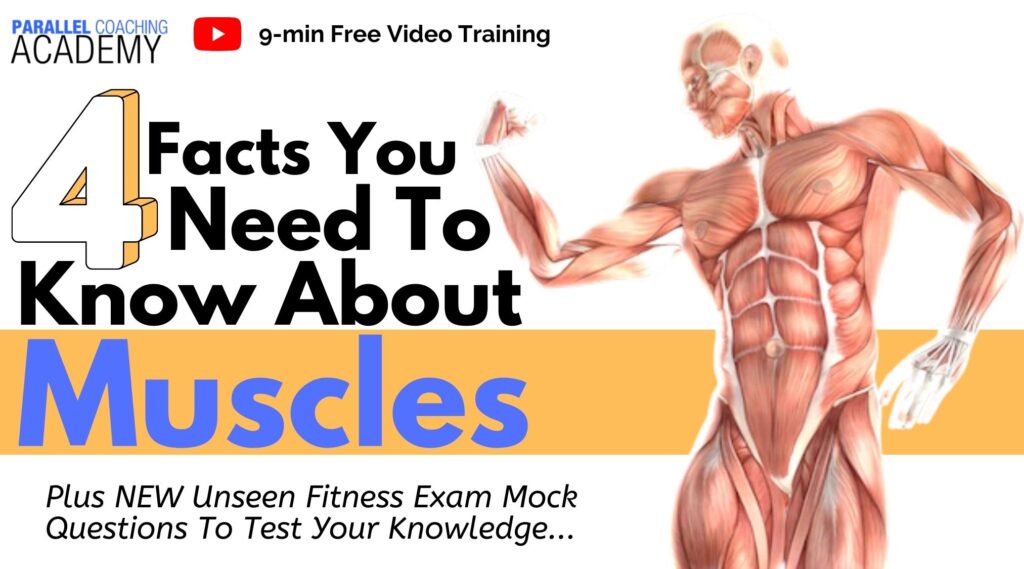This blog will explain the 4 facts you need to know about muscles. It will help you prepare for the Level 2 Exam, and understand the foundations of muscle anatomy and physiology.
You’ll discover:
- Why you need to know about muscle anatomy
- 8 Minute Video Tutorial on the foundations of muscles
- 4 Facts you need to KNOW about Muscles
- And Three Example Mock Questions to test your knowledge
Why you need to know about muscle anatomy
“Muscles” are easily the largest topic to understand for your level 2 Anatomy and Physiology exam.
It is also important for understanding the practical element of training clients and planning. This becomes the foundation of understanding how muscles work in preparation for moving onto Level 3 knowledge about the body in motion.
Watch: 4 Facts you need to KNOW about Muscles to PASS your Level 2 Exam
4 Facts you need to KNOW about Muscles
These 4 facts are crucial to understanding the foundations of muscle anatomy.
1: A Muscle must cross a joint to make it move
2: Muscles work in pairs around a joint – Agonist/ Antagonist pairs
3: Reciprocal Inhibition – when the agonist contracts the antagonist relaxes
4: Eccentric and Concentric Contractions – know the prime mover of every exercise.
A Muscle must cross a joint to make it move
Most skeletal muscles have the primary role of creating action. Therefore, the muscle must cross at least one joint. As the muscle contracts, it shortens, which pulls on the bone and creates movement at the joint.
Muscles work in pairs around a joint – Agonist/ Antagonist pairs
Every muscle that creates a joint action is part of a pair. The biceps brachii is a pair with the Triceps Brachii, and the Quadricpes pair with the Hamstrings. These pairs sit either side of a joint, and abide bythe law of reciprocal inhibition.
Find out more about Agonist/ Antagonist pairs in this blog HERE
Reciprocal Inhibition – when the agonist contracts the antagonist relaxes
Reciprocal inhibition occurs in every muscle pair. This measn that when one muscle contracts the other muscle is relaxing.
Find out more about Reciprocal Inhibition in this blog HERE
Eccentric and Concentric Contractions – know the prime mover of every exercise.
There are two types of muscle contractions you need to know about.
When a muscle is contracted and shortening – we call this a concentric contraction.
When a muscle is contracted and lengthening – we call this an eccentric contraction.
Find out more about contractions in this blog HERE
Test your exam readiness with today’s mock questions:
[NOTE: The answers are below the 3rd questions]
1. What is the name given to a contraction whereby the muscle is contracted and shortening?
A. Isotonic
B. Isometric
C. Eccentric
D. Concentric
2. According to Recipricol Inhibition, when the prime mover contracts concentrically, what happens to the Antagonist muscle?
A. It relaxes
B. It eccentrically contracts
C. The muscle tightens
D. It isometrically contracts
3. Which of the following statements about muscles is false?
A. When the agonist contracts, the antagonist relaxes
B. A muscle must cross a joint to enable movement
C. Muscles work individually
D. Muscles work in pairs
What’s the CORRECT answer?
Answers to the mock questions are :
Question 1= D, Question 2 = A, Question 3 = C
If you want more mock questions like this, then you can download more Free Mock Questions: DOWNLOAD NOW
Need More Help with your Level 2 Anatomy Revision?
For Trainee FITPROS Taking Their L2 Anatomy & Physiology Exam.
Learn, Revise & Pass Your Level 2 Anatomy & Physiology Exam In Under 10-hours
(Without Having To Spend Hours Revising Or Feeling Overwhelmed)
If you want to get your revision structured, learn everything you need to know, and feel confident on exam day, then click the link below:

Dedicated to More
Hayley “facts you need to know about muscles” Bergman
Parallel Coaching
P.S. You can also find us on the following platforms:
Instagram: Follow Now
Facebook: Like Our Page
Twitter: Tweet Us
YouTube: Subscribe Here
Read More L2 Anatomy Blogs HERE


This is incredibly useful – thank you!!